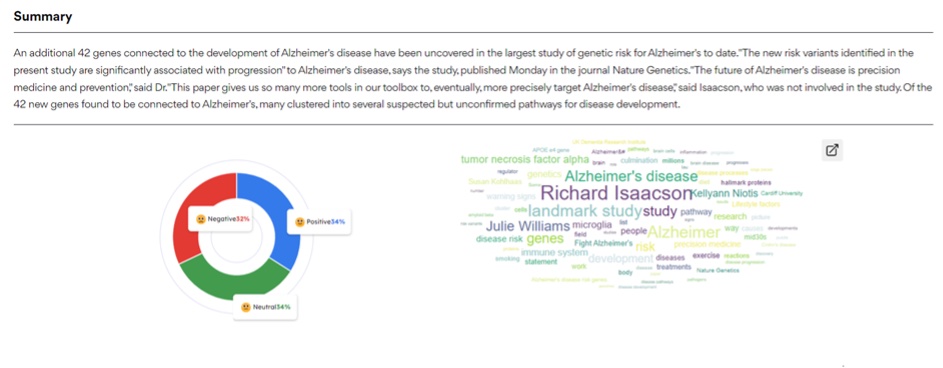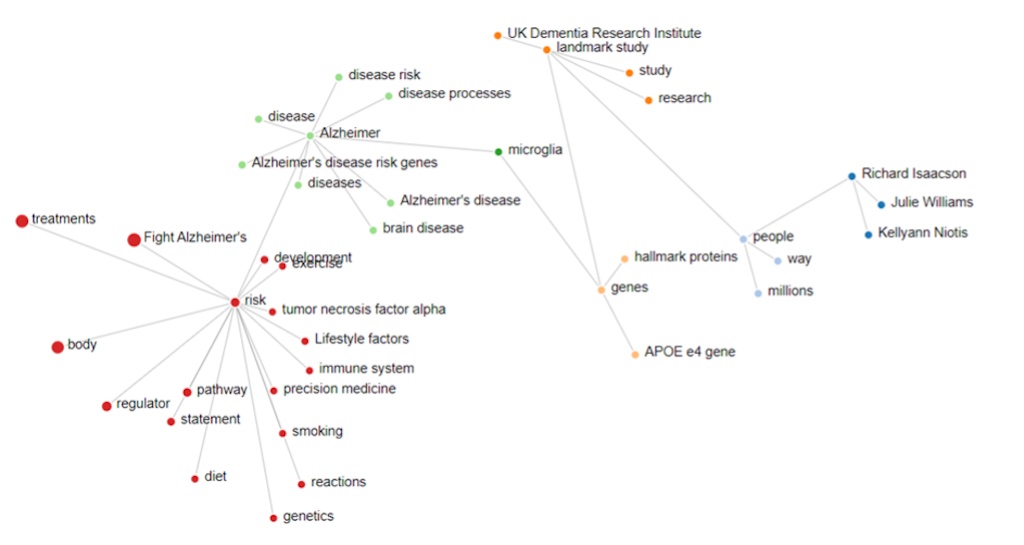Data is often referred to as the “oil” of the 21st century. In this age of Big Data, businesses are increasingly relying on vast quantities of information to make informed decisions. Textual data, specifically, is a significant source of this valuable resource. However, deciphering this raw, unstructured data can be challenging. This is where text visualization comes into play. Here’s how this revolutionary technique is reshaping business data analysis.
1. Simplifying Complex Data Structures
One of the most significant challenges with textual data is its inherent complexity. Unlike numerical data, which can be easily plotted on charts or graphs, textual data doesn’t lend itself to such straightforward representation. Text visualization tools transform this complex data into comprehensible visuals, helping users to identify patterns, correlations, and outliers at a glance.

Figure 2Wordcloud and Summary
For example, a word cloud can help identify the most frequently mentioned terms in a dataset, while a network diagram can show relationships between different terms. Such representations not only simplify the data but also facilitate quicker insights.
2. Enhancing Decision-Making Processes
Advertisement
Quick and informed decision-making is a cornerstone of successful business operations. Text visualization provides stakeholders with clear and concise visuals, making it easier for them to comprehend the information at hand. When managers can see patterns, trends, and anomalies visually, they can make more informed decisions.
For instance, a sentiment analysis tool might visually display public opinion on a new product launch. If the majority of the sentiment is negative, the business can immediately take corrective actions, such as addressing concerns or revising their marketing strategy. In tools such VizRefra, you are offered insights on sentiment analysis and topic relations to help create marketing strategy from feedback.
3. Facilitating Real-time Data Analysis
The contemporary business landscape requires real-time insights. Delays in understanding market dynamics or customer sentiments can lead to missed opportunities or severe repercussions. Text visualization tools can process and display data in real-time, ensuring that businesses stay one step ahead.
For example, consider a brand monitoring its social media mentions during a significant event, like Black Friday. A real-time text visualization tool can immediately highlight terms like “out of stock” or “website crash.” Such instantaneous insights enable businesses to react promptly, mitigating potential crises. This figure below from VizRefra, provides insight into the relationship between topics discovered from large text content.

Figure 3Topics Map
4. Empowering Non-Technical Users
Traditionally, data analysis required a specific set of technical skills. Only data scientists or analysts could make sense of vast datasets. However, text visualization has democratized data analysis, allowing even non-technical users to derive insights from complex textual information.
With intuitive dashboards and user-friendly interfaces, text visualization platforms enable marketing professionals, managers, and other stakeholders to interact with and interpret data without needing deep technical expertise. This widespread accessibility ensures that insights aren’t limited to a select few, promoting a data-driven culture throughout the organization.
5. Innovating Business Models and Strategies
In addition to aiding existing business processes, text visualization opens doors to entirely new strategies and models. Businesses can now tap into previously inaccessible or unusable data sources, like customer reviews, social media chatter, or lengthy documents, and transform them into actionable insights.
For instance, by visualizing customer feedback across various platforms, businesses can not only improve their products but also identify unmet needs or market gaps. Similarly, by analyzing employee feedback visually, companies can foster a better workplace culture, leading to increased productivity and job satisfaction.

Figure 4Entity Recognition
In Conclusion
The age of Big Data presents both opportunities and challenges. Textual data, with its vast potential and inherent complexity, epitomizes this duality. Fortunately, text visualization tools and techniques are bridging the gap between raw, unstructured data and actionable business insights. By simplifying data structures, enhancing decision-making, providing real-time analysis, empowering non-technical users, and promoting innovation, text visualization is indeed revolutionizing the way businesses approach and benefit from data analysis.
